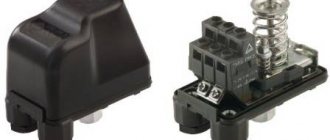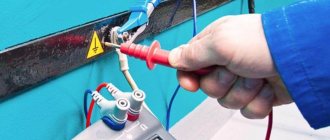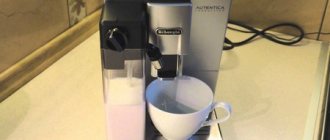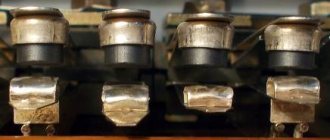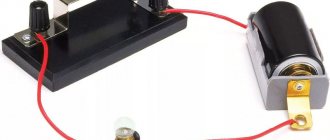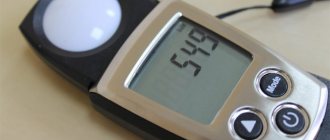Instruments for measuring pressure. Types and work. Application
The characteristic of pressure is the force that uniformly acts on a unit surface area of the body. This force influences various technological processes. Pressure is measured in pascals. One pascal is equal to a force of one newton applied to a surface area of 1 m2. Instruments are used to measure pressure.
Types of pressure
- Atmospheric pressure is generated by the Earth's atmosphere.
- Vacuum pressure is pressure that does not reach atmospheric pressure.
- Excess pressure is a pressure value that exceeds atmospheric pressure.
- Absolute pressure is determined from the value of absolute zero (vacuum).
Types and work
Devices that measure pressure are called pressure gauges. In technology, it is most often necessary to determine excess pressure.
A significant range of measured pressure values and special conditions for measuring them in various technological processes determine the variety of types of pressure gauges, which have their own differences in design features and operating principles. Let's consider the main types used.
Barometers
A barometer is a device that measures air pressure in the atmosphere. There are several types of barometers.
A mercury barometer works by moving mercury in a tube along a specific scale.
A liquid barometer works on the principle of balancing a liquid with atmospheric pressure.
An aneroid barometer works by changing the dimensions of a sealed metal box with a vacuum inside, under the influence of atmospheric pressure.
An electronic barometer is a more modern device. It converts the parameters of a conventional aneroid into a digital signal, which is displayed on a liquid crystal display.
Liquid pressure gauges
In these models of devices, the pressure is determined by the height of the liquid column, which equalizes this pressure. Liquid devices for measuring pressure are most often made in the form of 2 glass vessels connected to each other, into which liquid (water, mercury, alcohol) is poured.
Fig-1
One end of the container is connected to the medium being measured, and the other is open. Under the pressure of the medium, the liquid flows from one vessel to another until the pressure equalizes. The difference in fluid levels determines the excess pressure. Such devices measure pressure difference and vacuum.
Figure 1a shows a 2-pipe pressure gauge that measures vacuum, gauge and atmospheric pressure. The disadvantage is the significant error in measuring pressures that have pulsation. For such cases, 1-pipe pressure gauges are used (Figure 1b). They contain one edge of a larger vessel. The cup is connected to the cavity being measured, the pressure of which moves the liquid into the narrow part of the vessel.
When measuring, only the height of the liquid in the narrow elbow is taken into account, since the liquid changes its level in the cup insignificantly, and this is neglected. To measure small excess pressures, 1-pipe micromanometers with a tube inclined at an angle are used (Figure 1c). The greater the inclination of the tube, the more accurate the readings of the device, due to the increase in the length of the liquid level.
A special group is considered to be devices for measuring pressure, in which the movement of liquid in a container acts on a sensitive element - a float (1) in Figure 2a, a ring (3) (Figure 2c) or a bell (2) (Figure 2b), which are connected to an arrow, which is a pressure indicator.
Fig-2
The advantages of such devices are remote transmission and recording of values.
Strain gauges
In the technical field, strain gauges for measuring pressure have gained popularity. Their operating principle is to deform the sensing element. This deformation occurs under the influence of pressure. The elastic component is connected to a reading device having a scale graduated in pressure units.
Deformation pressure gauges are divided into:
- Spring.
- Bellows.
- Membrane.
Fig-3
Spring pressure gauges
In these devices, the sensitive element is a spring connected to the pointer by a transmission mechanism. Pressure acts inside the tube, the cross-section tries to take a round shape, the spring (1) tries to unwind, as a result the pointer moves along the scale (Figure 3a).
Diaphragm pressure gauges
In these devices, the elastic component is the membrane (2). It bends under pressure and acts on the arrow using a transmission mechanism. The membrane is made like a box (3). This increases the accuracy and sensitivity of the device due to greater deflection at equal pressure (Figure 3b).
Bellows pressure gauges
In bellows-type devices (Figure 3c), the elastic element is a bellows (4), which is made in the form of a corrugated thin-walled tube. Pressure is applied to this tube. At the same time, the bellows increases in length and, with the help of a transmission mechanism, moves the pressure gauge needle.
Bellows and membrane types of pressure gauges are used for measuring minor excess pressures and vacuum, since the elastic component has little rigidity. When such devices are used to measure vacuum, they are called draft gauges. The device that measures excess pressure is a pressure meter; draft and pressure meters are used to measure excess pressure and vacuum.
Devices for measuring pressure of the deformation type have an advantage over liquid models. They allow readings to be transmitted remotely and recorded automatically.
This occurs due to the conversion of the deformation of the elastic component into an electrical current output signal. The signal is recorded by measuring instruments that are calibrated in pressure units. Such devices are called strain-electric manometers. Strain gauge, differential transformer and magnetic modulation converters are widely used.
Differential transformer converter
Fig-4
The principle of operation of such a converter is to change the induction current depending on the pressure value.
Devices with such a converter have a tubular spring (1), which moves the steel core (2) of the transformer, and not the arrow. As a result, the strength of the induction current supplied through the amplifier (4) to the measuring device (3) changes.
Magnetomodulation devices for measuring pressure
In such devices, the force is converted into an electric current signal due to the movement of a magnet associated with an elastic component. When moving, the magnet acts on the magnetic modulation converter.
The electrical signal is amplified in a semiconductor amplifier and sent to secondary electrical measuring devices.
Strain gauges
Converters based on a strain gauge operate on the basis of the dependence of the electrical resistance of the strain gauge on the amount of deformation.
Fig-5
Strain gauges (1) (Figure 5) are fixed on the elastic element of the device. The electrical signal at the output arises due to a change in the resistance of the strain gauge, and is recorded by secondary measuring devices.
Electric contact pressure gauges
Electrical contact pressure gauges have become popular in alarm circuits, automatic process control systems, and thermal protection devices. The figure shows a diagram and view of the device.
Fig-6
The elastic component in the device is a tubular single-turn spring. Contacts (1) and (2) are made for any marks on the instrument scale by rotating the screw in the head (3), which is located on the outside of the glass.
When the pressure decreases and reaches its lower limit, the arrow (4) using contact (5) will turn on the lamp circuit of the corresponding color. When the pressure increases to the upper limit, which is set by contact (2), the arrow closes the red lamp circuit with contact (5).
Measuring pressure gauges are divided into two classes:
Model instruments determine the error of readings of working instruments that are involved in the production technology.
The accuracy class is interconnected with the permissible error, which is the amount of deviation of the pressure gauge from the actual values. The accuracy of the device is determined by the percentage of the maximum permissible error to the nominal value. The higher the percentage, the lower the accuracy of the device.
Model pressure gauges have an accuracy much higher than working models, since they serve to assess the consistency of the readings of working models of devices. Standard pressure gauges are used mainly in laboratory conditions, so they are manufactured without additional protection from the external environment.
Spring pressure gauges have 3 accuracy classes: 0.16, 0.25 and 0.4. Working models of pressure gauges have accuracy classes from 0.5 to 4.
Application of pressure gauges
Pressure measuring instruments are the most popular devices in various industries when working with liquid or gaseous raw materials.
We list the main places where pressure measuring instruments are used:
- Gas and oil industry.
- Heat engineering for monitoring energy carrier pressure in pipelines.
- Aviation industry, automotive industry, aircraft and automobile maintenance.
- Mechanical engineering industry in the use of hydromechanical and hydrodynamic units.
- Medical devices and instruments.
- Railway equipment and transport.
- Chemical industry for determining the pressure of substances in technological processes.
- Places using pneumatic mechanisms and units.
Related topics:
Strain gauge transducers
The principle of operation of strain gauge transducers is based on the dependence of the electrical resistance of the metal. Strain gauges are placed on the elastic sensing element of the pressure gauge. The change in their resistance is converted into an electrical signal and transmitted to secondary devices. To measure high and ultra-high pressures in laboratory practice, deadweight pressure gauges are used. You can purchase industrial equipment in the online store "Industrial Automation"
.
Sales department employees will help you navigate a large assortment of products, tell you about the features of the equipment and answer your questions by calling toll-free number 8
or at
Pressure gauge: design of a device for measuring pressure, its types and features
Very often in life, and especially in production, you have to deal with such a measuring device as a pressure gauge.
A pressure gauge is a device for measuring excess pressure. Due to the fact that this value can be different, the devices also have varieties. There are many areas of application for these devices. They can be used in the metallurgical industry, in any mechanical transport, housing and communal services, agriculture, automotive industry and other industries.
Depending on the purposes for which the devices are used, they are divided into different types. The most common are spring pressure gauges. They have their advantages:
- Measuring quantities over a wide range.
- Good technical characteristics.
- Reliability.
- Simplicity of the device.
In a spring pressure gauge, the sensing element is a hollow, curved tube inside. It can have a cross-section in the form of an oval or an ellipsoid. This tube deforms under pressure . It is sealed on one side, and on the other there is a fitting with which the value in the medium is measured. The end of the tube, which is sealed, is connected to the transmission mechanism.
The design of the device is as follows:
- Frame.
- Instrument arrows.
- Gears.
- Axis.
- Leash.
- Gear sector.
A special spring is installed between the teeth of the sector and the gear, which is necessary in order to eliminate backlash.
The measuring scale is presented in Bars or Pascals. The arrow shows the excess pressure of the medium in which the measurement is being taken.
The principle of operation is very simple. The pressure from the medium being measured enters the tube. Under its influence, the tube tries to level out, since the area of the outer and inner surfaces has different sizes.
The free end of the tube moves, and the arrow rotates at a certain angle thanks to a transmission mechanism. The measured value and the tube deformation are in a linear relationship.
That is why the value that the arrow shows is the pressure of a certain environment.
Types of pressure measurement systems
There are many different pressure gauges for measuring low and high pressure. But their technical characteristics are different. The main distinguishing parameter is the accuracy class. The pressure gauge will show more accurately if the value is lower. The most accurate are digital devices.
According to their purpose, pressure gauges are of the following types:
- Self-recording. They contain a mechanism that allows you to draw a graph of the device’s operation on paper.
- Railway. Used in railway transport.
- Ship's. Used on sea and river vessels.
- Reference. They have a high accuracy class. That is why they are used for testing, adjusting and checking other pressure measuring instruments.
- Special. Used to measure the value of various gases. Depending on what gas they are intended for, they have different body colors and marking letters: for measuring flammable gases - red, for non-flammable gases - black, yellow ammonia (A), white acetylene (Ac), blue oxygen (K).
- Electric contact. They have an electrical alarm that allows you to regulate the measured environment. These devices are divided into two types: based on an electrical contact attachment and with microswitches.
- General technical. Designed to measure pressure in various environments. They can measure excess and vacuum pressures.
Based on the principle of operation, the following types are distinguished:
- Piezoelectric. Based on the piezoelectric effect. A charge appears in a quartz crystal under mechanical action.
- Deformation. They are based on the deformation of the sensitive element (membrane, bellows, spring, etc.), which, when deformed, acts on the pointer.
- Liquid. Their basis is a tube filled with liquid. They can be of two types: with one or two tubes. Devices with two tubes are used to compare pressure in different environments.
- Piston. They consist of a cylinder with a piston inserted inside.
Liquid measurement systems
The value in these pressure gauges is measured by balancing the weight of the liquid column. A measure of pressure is the level of fluid in communicating vessels. These devices can measure values in the range of 10−105 Pa. They have found their application in laboratory conditions.
Essentially, it is a U-shaped tube containing a liquid with a higher specific gravity compared to the liquid in which the hydrostatic pressure is directly measured. This liquid is most often mercury.
This category includes working and general technical devices such as TV-510, TM-510. This category is the most in demand. They are used to measure the pressure of non-aggressive and non-crystallizing gases and vapors. Accuracy class of these devices: 1, 1.5, 2.5. They have found their application in production processes, in the transport of liquids, in water supply systems and in boiler rooms.
Electrical contact devices
This category includes pressure and vacuum gauges and vacuum gauges. They are intended for measuring the volume of gases and liquids, which are neutral in relation to brass and steel. Their design is the same as that of spring ones.
The only difference is in the large geometric dimensions. Due to the design of the contact groups, the body of the electrical contact device is large. This device can influence the pressure in a controlled environment by opening/closing contacts.
Thanks to the electrical contact mechanism used, this device can be used in an alarm system.
Reference meters
This device is intended for testing pressure gauges that measure values in laboratory conditions. Their main purpose is to check the serviceability of these working pressure gauges. A distinctive feature is a very high accuracy class. It is achieved thanks to design features and gearing in the transmission mechanism.
Special devices
These devices are used in various industrial sectors to measure the pressure of gases such as acetylene, oxygen, hydrogen, ammonia and others.
Basically, pressure can be measured with a special pressure gauge for only one type of gas. Each device indicates the gas for which it is intended.
The device is also colored to match the gas for which it can be used. The initial letter of gas is also written.
There are also vibration-resistant special pressure gauges that are capable of operating under strong vibrations and high pulsating environmental pressure. If you use a regular pressure gauge in such conditions, it will quickly break, since the transmission mechanism will fail. The main criterion for such devices is corrosion-resistant steel housing and tightness.
Ammonia systems must be corrosion resistant. Copper alloys are not allowed in the manufacture of acetylene measuring mechanisms.
This is due to the fact that upon contact with acetylene there is a risk of formation of acetylene explosive copper. Oxygen mechanisms must be fat-free.
This is due to the fact that in some cases even minor contact of pure oxygen and a contaminated mechanism can cause an explosion.
Recording devices
A distinctive feature of such devices is that they are able to record the measured pressure on a diagram, which will allow you to see changes at a certain time. They have found their application in industry with non-aggressive means and energy.
Ship and railway
Marine pressure gauges are designed to measure the vacuum pressure of liquids (water, diesel fuel, oil), steam and gas. Their distinctive features are high moisture protection, resistance to vibration and climatic influences. They are used in river and sea transport.
Railway gauges, unlike conventional pressure gauges, do not display pressure, but convert it into a signal of another type (pneumatic, digital, etc.). Various methods are used for these purposes.
Such converters are actively used in automation systems and process control. But despite their purpose, they are actively used in the nuclear energy, chemical and oil production industries.
Instruments for measuring pressure are divided into the following types:
- Thrust and pressure gauges are pressure and vacuum gauges that have extreme measurement limits of no higher than 40 kPa.
- Traction gauges are a vacuum gauge that has a measurement limit of (-40) kPa.
- A pressure gauge is a pressure gauge of low excess pressure (+40) kPa.
- Pressure and vacuum gauges are devices that are capable of measuring both vacuum and excess pressure in the range of 60–240,000 kPa.
- A vacuum gauge is a device that measures vacuum (pressure that is below atmospheric pressure).
- A pressure gauge is a device that is capable of measuring excess pressure, that is, the difference between absolute pressure and barometric pressure. Its limits range from 0.06 to 1000 MPa.
Most imported and domestic pressure gauges are manufactured according to all generally accepted standards. It is for this reason that it is possible to replace one brand with another.
When choosing a device, you must rely on the following indicators:
- The location of the fitting is axial or radial.
- The diameter of the fitting thread.
- Instrument accuracy class.
- Case diameter.
- Limit of measured values.
Liquid pressure gauges with sensing element
If you are planning to choose a liquid pressure gauge with a sensing element, then remember that their main advantage is that they are able to record pressure changes in a special diagram mode. Pressure measurement can occur thanks to the following sensitive elements:
- Float.
- To the bell.
- Ring.
- Pressure indicator.
These are the main sensitive elements that are actively used in these types of pressure gauges.
Why is there poor pressure in the water supply in the apartment?
There are 3 main causes of low blood pressure:
It is almost impossible to correct this on your own, but you can artificially increase it in an apartment or house using pumping equipment.
How to increase it?
The easiest way to increase the pressure is to install a pump. In stores you can find:
To guarantee results, it is better to install several of these devices. This can be done without asking permission from housing and communal services.
Simultaneous operation of several pumps can reduce the pressure of other residents . In this case, the court may order the removal of additional equipment from the water supply.
It is worth choosing equipment with a capacity of 3.5 m3 per hour and automatic adjustment. It is highly undesirable for the noise level to exceed 40 dB, otherwise additional sound insulation will be required. Flow pumps are connected to the pipes with two hoses.
A pumping station is a complex system that includes:
This design allows the system to be protected from even small pressure fluctuations. It analyzes the pressure value in real time, increases or decreases it depending on the specified parameters. This is necessary in the private sector, when several neighbors simultaneously begin watering their plots.
Step-by-step instructions on how to measure yourself
The owner of a private house should have complete information about the operation of the water supply, but the apartment owner should also sometimes measure the indicators. Installation of devices is simple and does not take much time. A step-by-step guide to measuring pressure without the help of specialists will help you avoid mistakes.
With pressure gauge
Installation of a stationary pressure gauge takes 1-3 hours . After unpacking and studying the assembly diagram, you can start working:
A portable pressure gauge is much faster and easier to assemble . It will take less than an hour:
Without meter
If it is not possible to buy measuring equipment, then you can use the contents of the pantry.
The first option is using a regular three-liter jar . To do this, you just need to measure how long it takes for the water to reach the neck:
The second option is a transparent hose . This method includes calculations, so you should stock up on pencil and paper:
Tasks
To learn how to solve problems under the guidance of an experienced teacher, come to online physics courses for grade 9!
Problem 1
Gasoline is poured into the canister and the height of the column is 0.6 m. The density of gasoline is 710 kg/m2. Determine the gasoline pressure at the bottom of the canister.
According to the formula that determines the pressure of a liquid on the walls of a vessel:
P = 710 × 9.8 × 0.6 = 4174.8 Pa = 4.7 kPa.
Answer : 4.7 kPa.
Problem 2
A weight weighing 3 kg was placed on a piston immersed in a cylinder of oil. The area of the piston is 2 cm2, and its weight is 300 g. What is the pressure force under the piston?
Source
Checking pressure based on water flow
The second way to determine pressure is to perform calculations using data on the amount of water flowing from the tap. In addition to this data, you will also need:
To calculate the pressure, you will need a 3-liter measuring container and a stopwatch. Place the container under the tap and note the time during which it is completely filled with water. It is possible to determine the approximate pressure after the operation, but the results obtained will be very inaccurate. Indeed, in any case, the jar will be completely filled in less than 10 seconds, which is why the resulting pressure value will be significantly less than according to the regulations. However, you should always start from the fact that a 3-liter container will be completely filled with water in 7 seconds or less. In this case, the pressure inside the pipeline will be closest to the regulated one.
Source
Selection rules
Different industries use different measuring instruments. To select the right pressure gauge you need to know the following requirements:
meter type;
- range of measurements taken;
- accuracy class;
- controlled environment;
- connecting dimensions;
- withstand load;
- terms of Use.
Measurements with guaranteed accuracy can be made after calibration and testing of the device. If necessary, it can be configured.
What will help determine?
A pressure gauge will help you find out the water pressure. On store shelves you can find many varieties of this device, which differ:
Another option is a portable pressure gauge . It consists of:
There are varieties that replace faucets and shower heads. Others, less accurate, can be put directly on the tap. Their installation does not require deep knowledge of plumbing. Anyone who has dealt with plumbing at least once in their life can handle this.
Electronic and electromechanical sensors stand apart . Such complex systems automatically control the pressure and increase or decrease the pressure. They are often part of pumping systems, for the installation of which it is worth calling professional plumbers.
Before measuring the pressure in an apartment or private house, you need to purchase a device for accurate measurements. There is a way to measure pressure without special equipment, indirectly, but such readings cannot be provided to the housing and communal services.
Operating principle
In a deformation (spring) pressure gauge, water enters a curved tube made of copper alloy. The water pressure causes the tube connected to the mechanism to deform, which causes the needle to turn.
Pressure gauges with a single-turn spring are designed for pressures up to 100 atm. To measure higher pressures, springs with several turns twisted into a spiral or screw are used.
There are devices in which a thin two-plate membrane is installed instead of a tube. They are suitable for viscous or contaminated solutions, withstand strong vibrations, but are sensitive to temperature fluctuations.

